Trajectory Based Operations
The next steps
Trajectory-based operations (TBO) is a cornerstone of the SESAR and FAA vision paving the way for more predictable air traffic management. TBO is about sharing a common plan for a flight’s trajectory, matching that trajectory to the performance needs of the circumstances, and delivering the trajectory via ATC clearances.
The objective is to implement Decision Support Tools that facilitate Air Traffic Controllers to accommodate flights on an efficient RNAV route directly to glide-slope intercept thus avoiding low-altitude path-stretching.
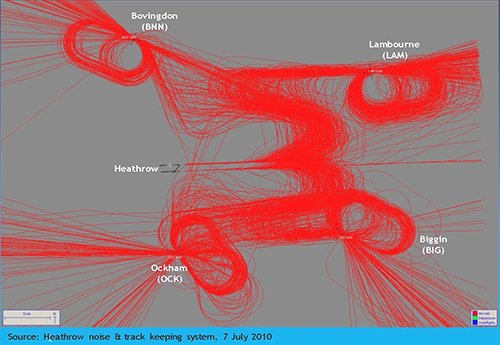
In the mid-1970s, EUROCONTROL initiated research into the advantages and feasibility of Trajectory Based Operations.
To verify verify the potential benefits of the TBO concept, in cooperation with the UK-CAA, a baseline study was performed using traffic inbound to London Heathrow
It concluded that a reduction of 20-25% in fuel consumption and 60% reduction in potential conflict situations might be feasible.
Trajectory Based Operations
The need for Trajectory Based Operations (TBO)
In the early 1980s, EUROCONTROL and the ANSPs of the United Kingdom and Belgium joined efforts to estimate the potential advantages from the introduction of a TBO strategy. During peak traffic periods, the radar tracks from traffic inbound to London-Heathrow and Brussel National were collected. The data covered the final part of the cruise phase and the descent.
Recorded traffic into Heathrow

In operations. the ATC strategy was driven by the expected demand/capacity balance, deduced from flight plan information. During Wave “A” and “C” the arrival sequence was managed by extending the flight paths through radar vectors.
Around 9 am it was expected that the demand would exceed the available runway capacity. Then, for some time, the traffic flow was managed through holding procedures. This resulted in a significant increase in excess distances flown compared to the published routes (Wave “B”) but achieving a lower landing rate than Wave “A”.
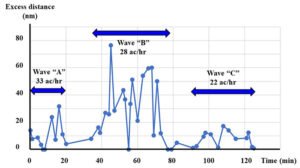
Quantify the potential advantages.
The study estimated the fuel burnt by the aircraft in the samples assuming different transit scenarios:
- The actual trajectories flown as recorded by the radar.
- A reference scenario where each aircraft would be accommodated on its User Preferred Trajectory. This is a theoretical option as it results in conflict situations.
- A hypothetical TBO scenario where each aircraft would be allocated the same RTA-constraint on the runway as recorded for the actual flight but would make maximum use of the cruise-descent speed range in its operational flight envelope.
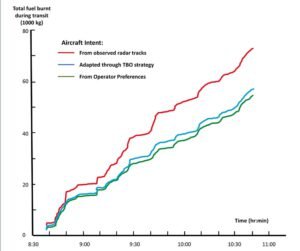
Conclusions
In the TBO scenario each flight was managed at the same transit time as its observed trajectory. Early adaptation of Aircraft Intent to the time constraints led to a potential reduction of 20-25% in fuel consumption. In addition, the organization of the traffic flow led to a 60% reduction in potential conflict situations.
Introduction of a TBO strategy could enhance safety, significantly reduce direct costs for the aircraft operators and reduce environmental impact. Every kilogram of fuel saved would be turned into greenhouse gases and did not generate noise while being burnt.
But there is a caveat: the TBO strategy requires application over an extended area. The 120 nm area used in the study already could bring significant advantages, but gate-to-gate operations would be preferable.
References
2022: The State of the Art
Today, the Network Manager aims to avoid major demand/capacity balance issues. Nevertheless, situations as depicted above still occur.
Current Decision Support Tools for Air Traffic Control, e.g., the Cross-Border Arrival Management function (XMAN) implemented to improve the performance of Air Traffic Control, do not even get close to these targets.
2022: State of the art
Today, the EUROCONTROL Network Manager aims to avoid demand/capacity imbalances. The UK has implemented SESAR’s Cross-Border Arrival Management tool that manages inbound traffic from up to 550 nm. What is the impact?
In May 2022 a one-hour sample of traffic inbound to Heathrow was recorded also covering 120 nm around Heathrow. The landing rate of 33 aircraft/hour was like the landing rate observed in Wave “A” of the 1980 data collection.
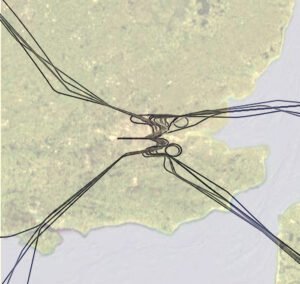
The tracks depict that adequate network management can avoid the need for excessive use of holding procedures.
Baseline
During Wave “A” in the 1980 study the average landing rate amounted to 33 aircraft/hour. Application of the TBO scenario hinted to possible fuel savings of some 20% if the excess distances due to radar vectoring could be compensated by cruise-descent speed control.

The average excess distance in Wave “A” was 10 nm. The 2022 data collection demonstrates a similar control strategy as observed in the 1980 collection. The average excess distance measured was 13 nm, i.e., 30% greater than observed in 1980.

TBO scenario
For each flight the “time-to-lose” was established from entry into the 120 nm control zone till its observed touch-down time.
These times are well within the control range of the Advanced Trajectory Management strategy. This would have allowed each aircraft to stay on its RNAV route to the runway without any radar vectors.
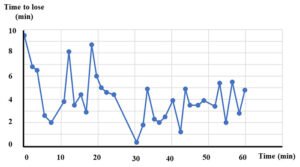
Conclusion
During the observation period, the Air Traffic Flow Management applied by the Network Manager pretty well adapted the traffic demand to the capacity of the London TMA.
However, the efficiency of ATC to manage the traffic flow is similar to the 1980 observations.
A paradigm change in Decision Support Tools for air traffic controllers is required to improve the ATC performance.
References
A paradigm change for Decision Support Tools is required
to bring real performance improvements.
Meet the actors …..
Air Traffic Controllers
The Decision-Making process of Controllers is based essentially on the prediction of the medium-term future.
This is facilitated by information ……..
- provided before the flight,
- sensed by ground-based installations,
- transponded from aircraft,
- computed from collated data,
- communicated by aircrew and other Controllers.
If the predicted future seems unsatisfactory, then remedial action is undertaken by requesting the Aircrew to update the Aircraft Intent through Clearances.
The Aircrew
Plan your flight – Fly your plan
The “plan”, aka Aircraft Intent, describes the planned route, altitude profile and sequence of air speeds used.
The “preferred” Aircraft Intent assumes that the flight is not affected by external disturbances.
Decision Support Tools (DSTs)
Decision Support Tools (DST) provide the Controllers with better support for making their decisions.
They require access to similar information as the Air Traffic Controllers.
- provided before the flight,
- sensed by ground-based installations,
- transponded from aircraft,
- computed from collated data,
- communicated by aircrew and other Controllers.
If the predicted future seems unsatisfactory, then remedial action is undertaken by requesting the Aircrew to update the Aircraft Intent through Clearances.
Setting the scene ….
The Air Traffic Control system is a complex, human-centered system comprising a wide variety of people and machines with many different competencies and capabilities.
The safe operation of aircraft is managed by the Aircrews.
The Ground System is best equipped for managing the traffic flows optimizing Safety, Efficiency and Sustainability.
The optimum sharing of Air Traffic Control tasks among Air Traffic Controllers and Air Crews is a challenge.
The European Organization for the Safety of Air Navigation, EUROCONTROL, has been at the forefront of R&D activities to improve Safety, Efficiency and Sustainability in Air Traffic Management.
R&D into Decision Support Tools at EUROCONTROL HQ from the end of the 1960s.
The tools evolved from straightforward “Conflict Alert” tools to the TMA 2010+ toolset based on the “Best Next Clearance” concept using Augmented Intelligence strategies.
Note:
conflict detection with prerequisite predicted trajectories
Dis cuss missed/false alerts
Then conflict resolution
Different solutions depending on target time horizon:
Conflict free trajectories
time horizon = medium term, e.g. 20 min. caveat: loss of capacity.
TBFM
ground based or airborne approach.
ground based
time to lose approach XMAN
airborne approach
added uncertainty upstream, loss of capacity at RTA point, sensitive to perturbations that affect RTA.
BNC
maximize capacity – better than approach without DST.
covers gate-to-gate trajectories.
BNC
describe conflict detection requirements:
Predicted trajectories
- aircraft Intent
- Aircraft performance model
- Meteorological model
- Trajectory calculation infrastructure
conflict detection alert
Missed & false alerts
Conflict resolution strategies
MTCD
Lorem ipsum dolor sit amet, consectetur adipiscing elit. Ut elit tellus, luctus nec ullamcorper mattis, pulvinar dapibus leo.
Read more …. button to page with return to here.
Conflict free trajectories
Lorem ipsum dolor sit amet, consectetur adipiscing elit. Ut elit tellus, luctus nec ullamcorper mattis, pulvinar dapibus leo.
Read more …. button to page with return to here.
TBFM
ground based
Accordion Content
Read more …. button to page with return to here.
TBFM
airborne based approach
Accordion Content
Read more …. button to page with return to here.
BNC
gate-to-gate extent
Read more …. button to page with return to here.
Conflict Alert
(CA)
Note:
prerequisite: predicted trajectories
Read more ....
The Conflict Alert (CA) function alerts Controllers for potential conflict situations within the target time horizon, e.g., covering the extent of their control sector.
A potential conflict is detected if the predicted separation between two flights is below a safe minimum.
Strategy
For each aircraft in the control zone a trajectory is predicted based on the published Aircraft Intent, predicted meteorological conditions and aircraft performance.
Caveat
Uncertainties in the actual Aircraft Intent applied, meteorological conditions and aircraft performance result in uncertainties in the predicted aircraft positions. This results in numbers of Missed and False Alerts presented to the Controllers that increase with the look-ahead time and traffic density
The increased controller workload makes Medium term conflict detection only effective in low to medium complexity enroute sectors.
Note: Decision support tools in operation today barely extend beyond safety net features providing last-minute alerts for evasive actions.
The way forward
Develop a Trajectory Based Strategy that reduces the number of potential conflicts by adapting the Aircraft Intent at entry into the control zone. This reduces the controller workload by reducing the False Alert rate.
Conflict Detection & Resolution
(CDR)
When the Conflict Alert module is complemented with a Conflict Resolution module, it will be possible to create conflict-free paths for the aircraft through the control zone. This reduces the controller workload significantly.
Strategy
At entry in the control zone, the Conflict Resolution module will compute for each aircraft an updated Aircraft Intent by adding additional altitude and radar vector clearances so that the potential conflict situations will be resolved.
Caveat
The uncertainty in the predicted aircraft positions increases with the look-ahead time. This forces the Conflict resolution module to apply separation criteria that are much greater than the minimum required radar separations.
The increased controller workload makes Medium term conflict detection only effective in low to medium complexity enroute sectors.
Increasing traffic complexity significantly reduces sector capacity and flight efficiency.
Consequently, the project was shelved after the International Conference on Automatic Conflict Detection and Resolution in Luxembourg, 1976
The way forward
Potential conflicts occur at points where traffic converges. Develop a Trajectory Based Strategy that ensures that predicted trajectories will achieve minimum radar separation at the convergence point. This reduces potential conflict situations and optimizes control sector capacity.
Time-Based Flow Management
(TBFM)
The Controllers strategy: Trajectory Prediction – Conflict Detection – Conflict Resolution is perfect for ensuring safety, but less efficient for smoothing traffic streams optimizing efficiency and sustainability. The conclusions from the 1976 Luxembourg seminar hinted on a requirement for a strategy change.
Paradigm change
The Conflict Detection & Resolution strategy starts from a Controller’s perspective:
Predict the future evolution from the “now” situation. Then take remedial action if required.
The limited accuracy of predicted trajectories limits the achievable time horizon in the control sector. In contrast, the TBO approach requires trajectory management over an extended part of the flight, aka multiple control sectors. This requires a paradigm shift.
Strategy
The focus of the traffic management strategy is changed from Conflict Detection to Conflict Resolution. First identify the convergence points of the traffic streams, then build a safe flow through scheduling and sequencing the individual aircraft whilst applying the minimum safety separations.
This defines for each aircraft the 4D-target conditions and thus the Required-Times-of-Arrival (RTAs) at the convergence points.
If the target conditions are different from the ones of the predicted trajectories based on the current Aircraft Intent, then the latter needs to be adapted. Depending on the control strategy and/or aircraft equipment the required control actions can either be performed through clearances by the Controllers or delegated to airborne automation.
Approaches implemented include Arrival Management tools (AMAN) that inform the Controllers about “Time-to-Loose or -Gain” or through negotiating the Required-Time-of-Arrival with the Flight Management System (FMS) in the aircraft.
Caveat
The TBFM strategy facilitates TBO through a negotiation process with all client actors. During the flight, multiple perturbations, e.g., meteorological conditions, availability of resources, Controller clearances, limitations in the operational flight envelop of aircraft, etc., may impact the feasibility of the RTA plan resulting in a stability and workload challenge.
The way forward
These caveats became apparent during a man-in-the-loop experiment in 1982. The validity of basis of the concept, i.e., the practicality of sequencing and sequencing at convergence points could be validated. The control strategy needs to be adapted to mitigate the impact of required variations of the RTAs when adapting the flows to the evolving real-life conditions.
Best Next Clearances
(BNC)
===> to be edited <===
The methodology proposed in this paper consists of an iterative approach that couples optimization and simulation to find solutions that are resilient to perturbations due to the uncertainty present in different phases of the arrival and departure process.
- The human factor: ATC relies heavily on human controllers to make decisions and manage traffic. Human errors can occur, and it is important to have systems in place to detect and mitigate these errors. Furthermore, ATC controllers are facing high workloads and stress, which can lead to fatigue, making them more prone to errors.
Lessons learned
Short term conflict alert is online at UAC Maastricht
The trajectory prediction function can be used in Flight Data processing Systems
Allocating conflict-free trajectories within a medium-term time horizon would result in an unacceptable reduction of sector capacity
EUROCONTROL-CAA project
1982: TBO concept implemented through trajectory synchronisation is not practical due to the impact of real-life perturbations
1980: Trajectory Based Operations have great potential for improving safety, efficiency and sustainability.
EEC simulation
1989: TBO concept implemented through air-ground synchronization of Aircraft Intent proved to be efficient .
Mode S experiment
2001: ARETA project proved that TBO through synchronization of aircraft Intent is compatible with existing Flight Data Processing Systems
integration at Belgocontrol
2003:FAA/EUROCONTROL COOPERATIVE R&D – Common Trajectory Prediction Capability
need
collaboration
DASC
2009: EUROCONTROL demonstrated the compatibility of air-ground synchronization of trajectories in low-medium density traffic and Aircraft Intent in high-density traffic conditions.
Global 09 demonstration
Lessons ignored
PHARE
Garteur
Concept
PD3
emperor sesar
Modal Box Title
Modal Box Content
EATCHIP/EATMP
SESAR-JU
datalink: focussed on air-ground trajectory synchronization
ASA focussed on TBO through trajectory synchronization (AMAN)
mention COMPAS, Maestro, CTAS
Validation programs became expensive so EU funding was required
EATMP progress unsatisfactory
Unsolicited proposal
Objectives
Based on PHARE results
Results in closing down EUROCONTROL R&D activities
Lessons learned
Short term conflict alert is online at UAC Maastricht
The trajectory prediction function can be used in Flight Data processing Systems
Allocating conflict-free trajectories within a medium-term time horizon would result in an unacceptable reduction of sector capacity
EUROCONTROL-CAA project
1982: TBO concept implemented through trajectory synchronisation is not practical due to the impact of real-life perturbations
1980: Trajectory Based Operations have great potential for improving safety, efficiency and sustainability.
EEC simulation
1989: TBO concept implemented through air-ground synchronization of Aircraft Intent proved to be efficient .
Mode S experiment
2001: ARETA project proved that TBO through synchronization of aircraft Intent is compatible with existing Flight Data Processing Systems
integration at Belgocontrol
2003:FAA/EUROCONTROL COOPERATIVE R&D – Common Trajectory Prediction Capability
need
collaboration
DASC
2009: EUROCONTROL demonstrated the compatibility of air-ground synchronization of trajectories in low-medium density traffic and Aircraft Intent in high-density traffic conditions.
Global 09 demonstration
Lessons ignored
PHARE
Garteur
Concept
PD3
emperor sesar
Modal Box Title
Modal Box Content
EATCHIP/EATMP
SESAR-JU
datalink: focussed on air-ground trajectory synchronization
ASA focussed on TBO through trajectory synchronization (AMAN)
mention COMPAS, Maestro, CTAS
Validation programs became expensive so EU funding was required
EATMP progress unsatisfactory
Unsolicited proposal
Objectives
Based on PHARE results
Results in closing down EUROCONTROL R&D activities
Lessons learned
Short term conflict alert is online at UAC Maastricht
The trajectory prediction function can be used in Flight Data processing Systems
Allocating conflict-free trajectories within a medium-term time horizon would result in an unacceptable reduction of sector capacity
EUROCONTROL-CAA project
1982: TBO concept implemented through trajectory synchronisation is not practical due to the impact of real-life perturbations
1980: Trajectory Based Operations have great potential for improving safety, efficiency and sustainability.
EEC simulation
1989: TBO concept implemented through air-ground synchronization of Aircraft Intent proved to be efficient .
Mode S experiment
2001: ARETA project proved that TBO through synchronization of aircraft Intent is compatible with existing Flight Data Processing Systems
integration at Belgocontrol
2003:FAA/EUROCONTROL COOPERATIVE R&D – Common Trajectory Prediction Capability
need
collaboration
DASC
2009: EUROCONTROL demonstrated the compatibility of air-ground synchronization of trajectories in low-medium density traffic and Aircraft Intent in high-density traffic conditions.
Global 09 demonstration
Lessons ignored
PHARE
Garteur
Concept
PD3
emperor sesar
Modal Box Title
Modal Box Content
EATCHIP/EATMP
SESAR-JU
datalink: focussed on air-ground trajectory synchronization
ASA focussed on TBO through trajectory synchronization (AMAN)
mention COMPAS, Maestro, CTAS
Validation programs became expensive so EU funding was required
EATMP progress unsatisfactory
Unsolicited proposal
Objectives
Based on PHARE results
Results in closing down EUROCONTROL R&D activities
Where are we now?
Heathrow story
1980 traffic
first managed through flight path extension. entry rate was appr 24 ac/hr. Around 9:20 the entry rate increased to 36 ac/hr. The controllers switched to managed the flow through the holdings.
